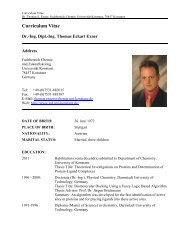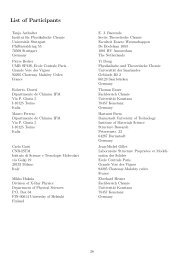The Role of the Lone Pairs in Hydrogen Bonding
The Role of the Lone Pairs in Hydrogen Bonding
The Role of the Lone Pairs in Hydrogen Bonding
You also want an ePaper? Increase the reach of your titles
YUMPU automatically turns print PDFs into web optimized ePapers that Google loves.
Monday, February 5 10:00-10:30<br />
High-resolution Compton pr<strong>of</strong>iles<br />
Pekka Suortti<br />
Department <strong>of</strong> Physical Sciences, PL 64, FIN-00014 Hels<strong>in</strong>ki University, F<strong>in</strong>land and European Synchrotron<br />
Radiation Facility, BP 220, F-38043 Grenoble, France, e-mail: Pekka.Suortti@hels<strong>in</strong>ki.fi, suortti@esrf.fr<br />
Compton scatter<strong>in</strong>g has played a decisive role <strong>in</strong> some developments <strong>of</strong> modern physics, first <strong>in</strong> <strong>in</strong>terpretation<br />
<strong>of</strong> photon scatter<strong>in</strong>g and conservation laws, <strong>the</strong>n <strong>in</strong> giv<strong>in</strong>g direct evidence that electrons <strong>in</strong><br />
solids obey Fermi-Dirac statistics. <strong>The</strong> history <strong>of</strong> Compton scatter<strong>in</strong>g is that <strong>of</strong> a dialogue between experiment<br />
and <strong>the</strong>ory at <strong>the</strong> deepest level, and <strong>the</strong>ory and experiment have taken <strong>the</strong> lead alternately.<br />
In this work <strong>the</strong> development <strong>of</strong> focus<strong>in</strong>g crystal spectrometers for Compton scatter<strong>in</strong>g studies from<br />
1930s to present is reviewed. <strong>The</strong> design pr<strong>in</strong>ciples have stayed <strong>the</strong> same, but <strong>the</strong> efficiency has improved<br />
much ow<strong>in</strong>g to <strong>the</strong> availability <strong>of</strong> large perfect crystal analyzers and efficient detectors. <strong>The</strong> reflectivity<br />
and energy resolution <strong>of</strong> <strong>the</strong> crystal can be tailored to <strong>the</strong> needs <strong>of</strong> <strong>the</strong> experiment by <strong>the</strong> asymmetric<br />
cut, thickness and bend<strong>in</strong>g radius <strong>of</strong> <strong>the</strong> crystal, and <strong>the</strong> response function <strong>of</strong> <strong>the</strong> spectrometer can be<br />
calculated precisely. <strong>The</strong> spectrometers at synchrotron radiation beaml<strong>in</strong>es achieve better than 0.1 a.u.<br />
momentum resolution, and several statistically accurate Compton spectra can be acquired <strong>in</strong> one day.<br />
<strong>The</strong> latest developments <strong>in</strong>clude spectrometers that operate <strong>in</strong> <strong>the</strong> 100 keV range, and count rates are<br />
enhanced by us<strong>in</strong>g wide energy bands and dispersion compensation. Experimental momentum density <strong>of</strong><br />
crystall<strong>in</strong>e LiH is compared with results <strong>of</strong> a Hartree-Fock calculation <strong>in</strong> terms <strong>of</strong> directional Compton<br />
pr<strong>of</strong>iles and reciprocal form factors. <strong>The</strong> agreement is excellent, and <strong>the</strong> residual differences are attributed<br />
to electron-electron correlation, which is not <strong>in</strong>cluded <strong>in</strong> <strong>the</strong> H-F calculation. <strong>The</strong> correlation energy<br />
is calculated from <strong>the</strong> second moment <strong>of</strong> <strong>the</strong> difference between experimental and <strong>the</strong>oretical Compton<br />
pr<strong>of</strong>iles.<br />
2






